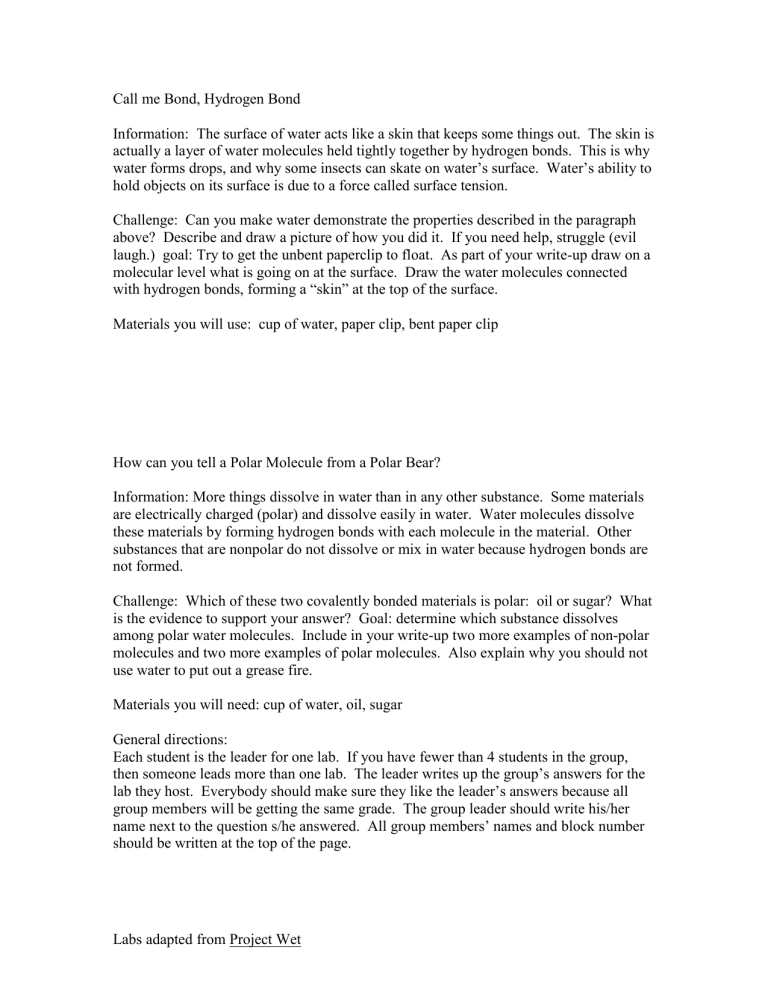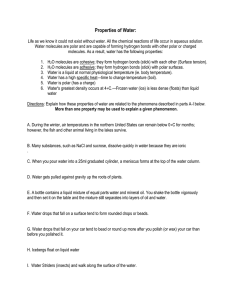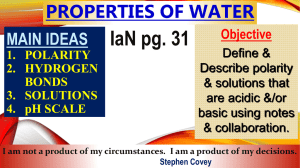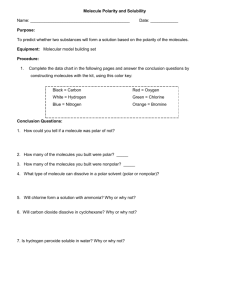Call me Bond, Hydrogen Bond

Call me Bond, Hydrogen Bond
Information: The surface of water acts like a skin that keeps some things out. The skin is actually a layer of water molecules held tightly together by hydrogen bonds. This is why water forms drops, and why some insects can skate on water’s surface. Water’s ability to hold objects on its surface is due to a force called surface tension.
Challenge: Can you make water demonstrate the properties described in the paragraph above? Describe and draw a picture of how you did it. If you need help, struggle (evil laugh.) goal: Try to get the unbent paperclip to float. As part of your write-up draw on a molecular level what is going on at the surface. Draw the water molecules connected with hydrogen bonds, forming a “skin” at the top of the surface.
Materials you will use: cup of water, paper clip, bent paper clip
How can you tell a Polar Molecule from a Polar Bear?
Information: More things dissolve in water than in any other substance. Some materials are electrically charged (polar) and dissolve easily in water. Water molecules dissolve these materials by forming hydrogen bonds with each molecule in the material. Other substances that are nonpolar do not dissolve or mix in water because hydrogen bonds are not formed.
Challenge: Which of these two covalently bonded materials is polar: oil or sugar? What is the evidence to support your answer? Goal: determine which substance dissolves among polar water molecules. Include in your write-up two more examples of non-polar molecules and two more examples of polar molecules. Also explain why you should not use water to put out a grease fire.
Materials you will need: cup of water, oil, sugar
General directions:
Each student is the leader for one lab. If you have fewer than 4 students in the group, then someone leads more than one lab. The leader writes up the group’s answers for the lab they host. Everybody should make sure they like the leader’s answers because all group members will be getting the same grade. The group leader should write his/her name next to the question s/he answered. All group members’ names and block number should be written at the top of the page.
Labs adapted from Project Wet
It’s no Sweat, or is It?
Information: It is a very hot day. You and some friends decide to race around the block to the playing field (because you are insane.) Suddenly one of your friends stops and complains about feeling overheated (serves her right!) You happen to be carrying a bottle of suntanning oil and a bottle of water. One friend says oil will help cool down the overheated friend; the other claims water will work better.
Challenge: Figure out which friend is correct….Which cools you off better, oil or water.
Try spreading a thin layer of each liquid on your hand. Which one feels cooler? Write a discussion about perspiration and tell why a person perspires. Yes, we know that when you get hot, you perspire, but why? Why do we sweat?
Next, compare the size of an oil molecule to a water molecule. Which one do you think will evaporate faster? Also think about our skin…is our skin polar or non-polar? Which do you think will want to stick to our skin longer…oil or water? Why do you think this?
Materials you will need: oil, water, your finger
Freezing Water is a Swell Idea
Information: You plan to go on a hike tomorrow. You want to bring along some water.
You have water in both glass and plastic bottles. A friend suggests freezing the filled bottles overnight, so the water will still be cool when you need a drink.
Challenge: Which container of water should you put in the freezer? Draw a picture of and provide an explanation for what you think EACH might look like when you check the freezer in the morning. (Don’t try this one at home!) You should also discuss how hydrogen bonding affects the alignment of water molecules when water freezes.
No materials needed: this is a mental lab!
General directions:
Each student is the leader for one lab. If you have fewer than 4 students in the group, then someone leads more than one lab. The leader writes up the group’s answers for the lab they host. Everybody should make sure they like the leader’s answers because all group members will be getting the same grade. The group leader should write his/her name next to the question s/he answered. All group members’ names and block number should be written at the top of the page.
Labs adapted from Project Wet











